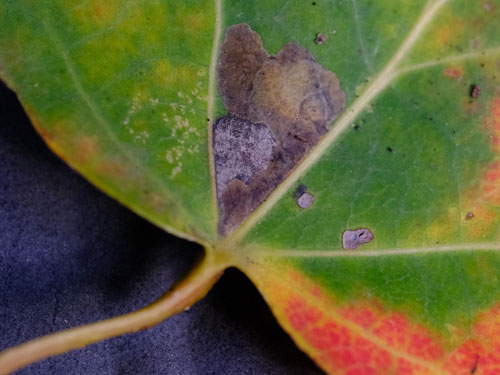


Distinctive triangular mine of Ectoedemia argyropeza in green island at the base of leaf of Populus tremula

Gall in petiole of leaf of Populus tremula produced by the larva of Ectoedemia argyropeza
At this time of year, in among the fallen autumn leaves, it is possible to spot many that, while mostly an autumnal shade of brown, red or gold, will have a patch that is still as bright green as it was when it was still attached to the tree that it fell from. Closer inspection will reveal that where one of these patches, or ‘green island’, exists there will also be a blister or burrow within the leaf that has been produced by the larva of one of many species of tiny moths - a so-called ‘leaf miner’. The green island is a result of a symbiotic relationship between the larva and a species of bacterium (usually Wolbachia sp.). The bacterium produces cytokinin hormones that adapt the physiology of the host leaf so that it remains green in order that the larva can continue to feed on live living tissue even after the leaf has dropped.
There a number of species that produce these ‘green island’ and they can also be found on the leaves of a number of different tree species. One in particular is Aspen Populus tremula which is host to the larvae of Virgin Pigmy Ectoedemia argyropeza. E. argyropeza, a member of the family Nepticulidae is a tiny black and white moth (with a wingspan of about 6mm) that can be found by day on the trunks of Aspen. It is locally distributed in southern England but there are very few records from Sussex. We have no records at all of the adult moths, only of the larvae and their very distinct mines in the Aspen leaves. The larva starts its mining journey in the petiole forming a gall and later burrows its way into the leaf forming a triangular blotch-mine in a ‘green island’ to one side of the mid-rib at the base of the leaf.
It's worth checking the fallen leaves of Aspen for the mines of this moth and, if you spot them (or the mines of any other species for that matter), please put photos of them on iRecord with detail of the plant species in which they were found. There's lots more information on leafminers, with guides to species, their hostplants and much more, on the British Leafminers website.
Every month it is our aim to highlight a species that is “in-season” and, although not necessarily rare or difficult to identify, has been highlighted by our local recording groups as being somewhat under-recorded and for which new records would therefore be welcomed.
If you or your recording group are aware of species such as this then please contact Bob Foreman.